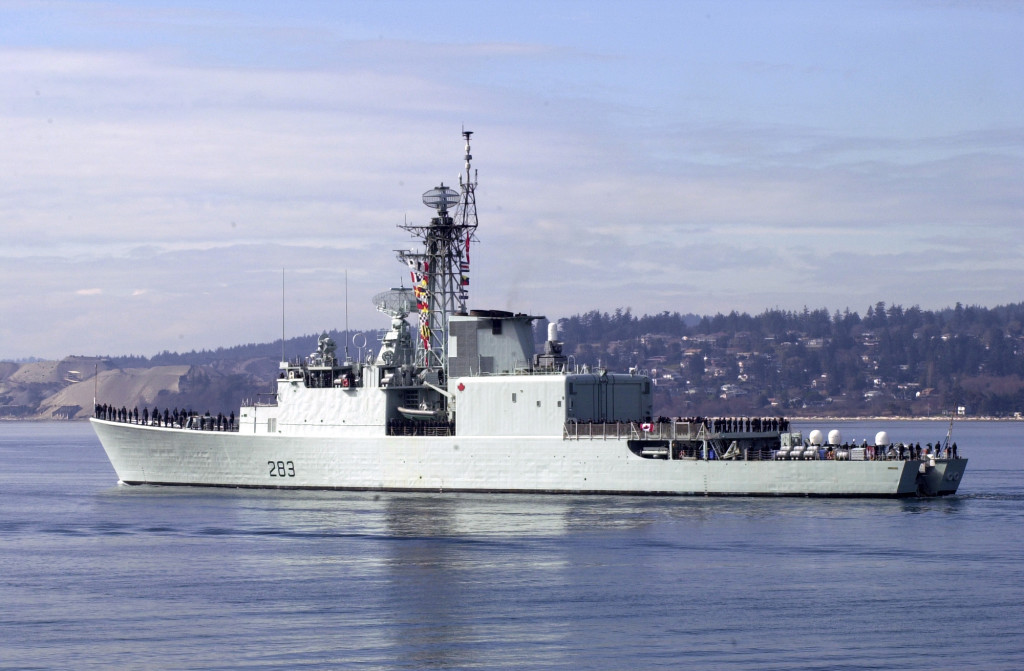
As the Royal Canadian Navy undergoes its most extensive peacetime modernization in history, Vice-Admiral Mark Norman, Commander of the Royal Canadian Navy (RCN), announced September 19 the upcoming retirement of four ships that have reached the end of their operational lives.
The ships are Her Majesty’s Canadian Ships (HMCS) Protecteur and Preserver, two Protecteur-class auxiliary oil replenishment ships; and HMC Ships Iroquois and Algonquin, two Iroquois-class guided missile destroyers.
The retirement of these vessels has been anticipated for some time and is a step towards the introduction of new ships and capabilities set to be delivered through the National Shipbuilding Procurement Strategy (NSPS), as well as recognition of the RCN’s commitment to the responsible use of public funds while maintaining Canada’s naval readiness.
This period of transition includes the modernization of the RCN’s 12 Halifax-class frigates and the procurement of three new classes of ships, including the Joint Support Ships, the Arctic/Offshore Patrol Ships and the Canadian Surface Combatants, as well as the integration of a new maritime aircraft into fleet service.
During this period of transition, the RCN will be able to count on its modernized Halifax-class frigates, Victoria-class submarines and Kingston-class vessels to carry out the tasks and missions set by the Government of Canada.
The Government of Canada is delivering equipment to the RCN by investing $4 billion to modernize the Halifax-class frigates, and $36.6 billion on the NSPS for the recapitalization of the federal surface fleet during the coming decades.
The RCN has a plan in place to address the many challenges of transition, including the need to maintain excellence in operations, to deliver the future fleet and to prepare the RCN for the new capabilities and technologies that will be delivered through the NSPS over the next decade and beyond.
Quick facts
HMCS Iroquois
- HMCS Iroquois is a guided missile destroyer and the lead ship of the Iroquois Class, which comprises HMCS Athabaskan on the East Coast, and HMCS Algonquin on the West Coast.
- HMCS Iroquois has been scheduled for divestment since November 2011.
- HMCS Iroquois will prepare for its official paying off ceremony in January 2015 in Halifax.
HMCS Algonquin
- HMCS Algonquin is a guided missile destroyer, the fourth ship of the Iroquois Class.
- On August 30, 2013, HMCS Algonquin was involved in a collision at sea with HMCS Protecteur while conducting exercise manoeuvres en route to Hawaii. There were no injuries. The ship was able to return to its home port of Esquimalt, B.C., to undergo a full damage assessment.
- It was assessed that HMCS Algonquin suffered extensive damage to its port side hangar and remained alongside in Esquimalt.
- Considering the relatively short service life remaining for HMCS Algonquin, which was scheduled to be retired in early 2019, and its current state of repair, the cost to reinstate this ship to full operational capability no longer represents a responsible use of public funds. As a result, HMCS Algonquin will begin preparations for pay off in the near future.
- A Board of Inquiry (BOI) was convened to further investigate the incident and circumstances surrounding it, and will make recommendations as to how to prevent a similar event from occurring in the future.
HMCS Protecteur
- HMCS Protecteur is an auxiliary oil replenishment ship based in Esquimalt, B.C., and the lead ship of the Protecteur Class. Its sister ship, HMCS Preserver, is based in Halifax.
- HMCS Protecteur was designed to carry a large amount of supplies, including fuel, dry cargo and ammunition, which could be transferred to other ships through hook-up lines and re-fuelling hoses in a manoeuvre known as a replenishment at sea.
- HMCS Protecteur will be officially retired after sustaining serious damage in a fire in February 2014. An extensive assessment of HMCS Protecteur has concluded that the ship was damaged beyond economical repair.
- Considering the relatively short service life remaining for HMCS Protecteur, which was scheduled to be retired in 2017, and its current state of repair, the cost to reinstate the ship to full operational capability would not represent a responsible use of public funds. As a result, the ship will remain alongside and be prepared for disposal as early as is practically feasible.
- A BOI has been convened to investigate the cause of the fire on board HMCS Protecteur and the circumstances surrounding it. The BOI, which is still ongoing, will make recommendations as to how to prevent a similar event from occurring in the future, and its results will be made public when available.
HMCS Preserver
- HMCS Preserver is rapidly approaching the end of its operational life, which was planned for 2016.
- Engineering surveys conducted in recent months identified levels of corrosion in HMCS Preserver that have degraded the structural integrity of the ship below acceptable limits, specifically in the vicinity of the port side boiler room.
- As a result of its current material state, and considering the relatively short service life remaining for HMCS Preserver, the cost to reinstate this ship to full operational capability does not represent a responsible use of public funds. HMCS Preserver will therefore cease its operational life, remain alongside and prepare for pay off in the near future.